|
|
|
Sort Order |
|
|
|
Items / Page
|
|
|
|
|
|
|
| Srl | Item |
| 1 |
ID:
109193
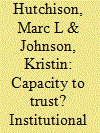

|
|
|
|
|
| Publication |
2011.
|
| Summary/Abstract |
Civil conflict and state failure has often been linked to breakdowns in regime legitimacy. Trust in government is a critical element of regime legitimacy and the state's ability to mediate between the demands of competing groups within society. We contend that government capability is a primary factor in shaping individuals' ascription of legitimacy to the state. Capable governments foster perceptions of legitimacy while poor institutional performance decreases the degree to which individuals trust their government. While some tests of this relationship exist in extant literature, much of the work fails to integrate both micro- and macro-level factors, is confined to regions with established state performance, or is based on single-country studies. Our approach avoids many of these deficiencies by using 32 Afrobarometer surveys collected across 16 different countries from 2000 to 2005 and employing hierarchical linear models to estimate the effects of temporal-specific, state-level variables on levels of individual trust. We find that higher institutional capacity is associated with increased levels of individual trust in government across African countries. Furthermore, we demonstrate that this effect on political trust is independent of other individual-level attitudes, socio-economic characteristics, and a state's prior internal conflicts.
|
|
|
|
|
|
|
|
|
|
|
|
|
|
|
|
| 2 |
ID:
109196
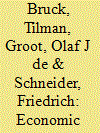

|
|
|
|
|
| Publication |
2011.
|
| Summary/Abstract |
In this article, we estimate the total costs of the German participation in the Afghanistan war, both past and future. This is a hugely complex and uncertain calculation, which depends on several important assumptions. These assumptions pertain to the different cost channels and the shares of these channels that can be attributed to the German participation in the war. By calculating the costs of the German participation, we provide a framework for other researchers to do the same with respect to other countries. The article can function as a roadmap for researchers focusing on this topic. In the end we find that, in the most realistic of several possible scenarios regarding the duration and intensity of the German participation in the war in Afghanistan, the German share of the net present value of the total costs of the war ranges from 26 billion Euro to 47 billion Euro. This large range reflects the uncertainties with which the costs must be estimated. On an annual basis, we estimate that the German participation in the war costs between 2.5 and 3 billion Euro. This contrasts with the official war budget, which is little over 1 billion Euro for 2010, showing that governments may not adequately represent the costs of military action.
|
|
|
|
|
|
|
|
|
|
|
|
|
|
|
|
| 3 |
ID:
109192
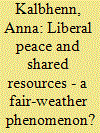

|
|
|
|
|
| Publication |
2011.
|
| Summary/Abstract |
The aim of this article is to empirically analyse liberal peace arguments in the context of shared river basins. In particular, it argues that counter to the water war hypothesis, sharing a river need not necessary lead to conflict over the shared resource: relying on liberal arguments, joint democracy is expected to facilitate trust and thus cooperation over transboundary rivers. Furthermore, by mitigating asymmetries, facilitating (implicit) side-payments and issue linkage, both economic and political interlinkages may encourage cooperation over shared rivers. Previous work suggests that these factors might be a 'fair-weather' phenomenon, that is, that they play a role only for problems that are easy to solve. In this article, liberal effects are allowed to vary with the difficulty of the underlying problem by separating different issues and geographic situations. Empirically, the article focuses on intergovernmental behaviour using a new dataset on transboundary water events covering all international basins for a period of eleven years (1997-2007). The results show that indeed liberal peace factors matter with respect to intergovernmental interaction over shared river basins and the effect of joint democracy is more prominent under 'fair-weather' conditions.
|
|
|
|
|
|
|
|
|
|
|
|
|
|
|
|
| 4 |
ID:
109195
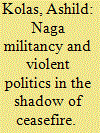

|
|
|
|
|
| Publication |
2011.
|
| Summary/Abstract |
Ceasefires are often seen as a simple measure to end violence and allow more substantive negotiations to begin. Contemporary conflict resolution models thus posit the ceasefire as a basic step in the peacebuilding trajectory. Offering an in-depth analysis of Naga militancy in Northeast India, this article argues that ceasefires should rather be understood as a part of the dynamics of conflict. Northeast India is a site of protracted conflict involving multiple contestants, where Naga militant organizations play a key role. A string of ceasefires since 1997 between the Indian government and the National Socialist Council of Nagalim (NSCN) has contained fighting between security forces and militants, while violence has continued unabated between NSCN factions and among an array of other armed groups in the area claimed as 'Nagalim', with serious consequences for local communities. This study suggests that ceasefires may impact on conflict dynamics in at least three ways, all interrelated: (1) by affecting the internal cohesion of belligerent groups, (2) by affecting the operational space of armed groups, and (3) by affecting the relations between multiple stakeholders and parties to a conflict, including but not limited to the challenger(s) and the state. The study concludes that the terms of ceasefire agreements, the strategic use of ceasefires by conflict actors, and the opportunities created by a lack of effective monitoring of ceasefire ground rules has facilitated the operations of militants vying for territory, revenues from illegal 'taxation' and political stakes. Ceasefires have also paved the way for an escalation of factional and intergroup fighting and violent politics in Northeast India, by empowering signatory groups versus contenders as well as nonviolent actors.
|
|
|
|
|
|
|
|
|
|
|
|
|
|
|
|
| 5 |
ID:
109197
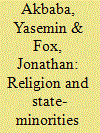

|
|
|
|
|
| Publication |
2011.
|
| Summary/Abstract |
This article presents the Religion and State-Minorities (RASM) dataset addressing its design, collection, and utility. RASM codes religious discrimination by governments against all 566 minorities in 175 countries which make a minimum population cutoff. It includes 24 specific types of religious discrimination coded yearly from 1990 to 2002. Religious discrimination measures the absence of the human right of religious freedom which includes limits on religious practices such as worship as well as limits on religious institutions such as churches and mosques which are not placed on the majority group. Thus the dataset focuses on the restriction of religious group rights. Most similar datasets, including those that focus on human rights in general, include a single discrimination score for a country. RASM is the first to contain an accounting of religious discrimination against all relevant religious minorities on an individual basis while avoiding some methodological problems of previous similar data collections. In order to demonstrate the utility of the dataset, we examine the relationship between religious identity and religious discrimination. We find that both majority and minority identities matter in predicting the treatment of religious minorities. This demonstration that codings for individual minorities add to our understanding of the correlates of religious discrimination is illustrative of the potential uses of this dataset. It also indicates that this type of data can be useful in other types of studies where dyads based on religious identity are relevant, such as studies of ethnic conflict and civil war.
|
|
|
|
|
|
|
|
|
|
|
|
|
|
|
|
| 6 |
ID:
109191
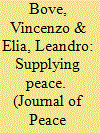

|
|
|
|
|
| Publication |
2011.
|
| Summary/Abstract |
We explore the supply side of peacekeeping - the determinants of a country's voluntary contributions to peacekeeping operations. We focus on troop contribution and examine a large set of operations, from UN-led missions to operations led by NATO, the African Union, the European Union, and ad hoc coalitions. We rely on a theoretical model of the private provision of public goods and a dataset on troop contribution across 102 states and 45 operations from 1999 to 2009 to explain both the conditions under which third-party actors are more or less likely to intervene in peacekeeping operations and the factors determining the size of their personnel contribution. We use the characteristics of the conflict to identify which types of conflicts attract outside intervention and the characteristics of the intervener to identify the countries more willing to provide troops. We show that at the domestic level, contributions are driven by the comparative advantage in manpower - or the relative value of labor - and constrained by the tolerance of casualties and the sustainability of multiple and concurrent missions. At the international level, the most robust explanations of when states choose to intervene are the level of threat to global and regional stability, the proximity to the conflict area, and the number of displaced people. In particular, security and humanitarian concerns trigger nation-specific responses. Our empirical findings provide further evidence of the centrality of country-specific gains in explaining the participation in peacekeeping. However, contributor-specific benefits play the same role in UN and non-UN peacekeeping missions, in contrast with previous empirical studies on the financial burden-sharing.
|
|
|
|
|
|
|
|
|
|
|
|
|
|
|
|
| 7 |
ID:
109194


|
|
|
|
|
| Publication |
2011.
|
| Summary/Abstract |
This article examines the development of cooperative relationships in back-channel communication and their impact on intraparty negotiation. It draws on extensive newly available evidence on back-channel communication in the Irish peace process to expand the range of detailed case studies on a topic which is shrouded in secrecy and resistant to academic inquiry. The article analyses the operation of a secret back channel that linked the Irish Republican Army to the British government over a period of 20 years, drawing on unique material from the private papers of the intermediary, Brendan Duddy, and a range of other primary sources. The article finds that interaction through this back channel increased predictability and laid a foundation of extremely limited trust by providing information and increasing mutual understanding. Strong cooperative relationships developed at the intersection between the two sides, based to a great extent on strong interpersonal relationships and continuity in personnel. This in turn produced direct pressure for changes in the position of parties as negotiators acted as advocates of movement in intraparty negotiations. The article finds that this back channel was characterized by a short chain, the direct involvement of principals and the establishment of a single primary channel of communication and that these features combined with secrecy to generate the distinctive cooperative dynamics identified in this article. It concludes that the potential for the development of cooperative relationships is particularly strong in back-channel negotiation for two reasons; first, the joint project of secrecy creates an ongoing shared task that builds trust and mutual understanding regardless of progress in the negotiations. Secondly, as a shared project based on the explicit aim of bypassing spoilers, the process creates structural pressures for cooperation to manage internal opponents on both sides, pressures intensified by the secrecy of the process.
|
|
|
|
|
|
|
|
|
|
|
|
|
|
|
|
|
|
|
|
|